Earth is a unique planet — the only one we know of in the entire universe that supports life. What makes Earth so special is a combination of perfect conditions: it’s the right distance from the sun, allowing for mild temperatures, liquid water, and a stable atmosphere with oxygen to breathe. It also has a magnetic field that protects life from harmful solar radiation, and a rich mix of elements and minerals needed by living organisms.
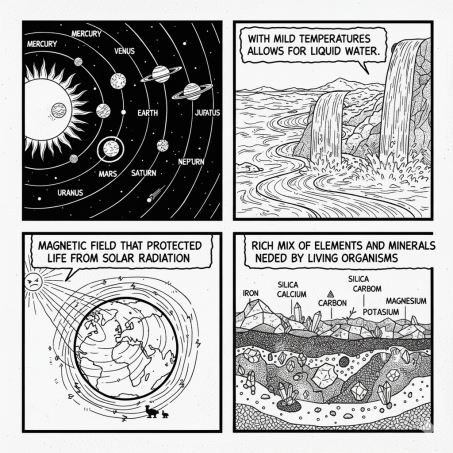
Over millions of years, nature has evolved into a finely tuned system where organisms depend on one another to survive — plants, animals, fungi, and microbes each playing a role. Pollinators help plants reproduce, decomposers recycle nutrients, predators keep populations in check, and plants provide food and oxygen. This web of relationships creates a delicate equilibrium. When it’s in balance, life flourishes. When it’s disrupted, the entire system can weaken. Nature isn’t a collection of isolated parts — it’s a living network, designed by evolution to sustain itself.
One of the main reasons life is possible on Earth is because of plants. Through photosynthesis, plants convert sunlight into energy-rich food — and animals gain that energy when they eat plants. In fact, the majority of living organisms on Earth rely on plants either directly or indirectly for food, making them the foundation of most food chains. Just as importantly, while plants are creating energy, they also release oxygen into the air — a byproduct of photosynthesis that makes it possible for animals and humans to breathe.
Beyond food and oxygen, every part of a plant — from its leaves and seeds to its nectar and wood — provides food and shelter for other living things. Plants also help clean the air, store water, stabilize soil, and support the overall health of ecosystems.
Photosynthesis is the process that allows plants to turn sunlight, carbon dioxide, and water into sugar (glucose), which they use for energy. In doing so, they also release oxygen — a vital byproduct that animals, including humans, need to breathe. This process happens mostly in leaves, where a pigment called chlorophyll captures the sun’s energy. Without photosynthesis, Earth would have no breathable atmosphere and no energy at the base of food chains.
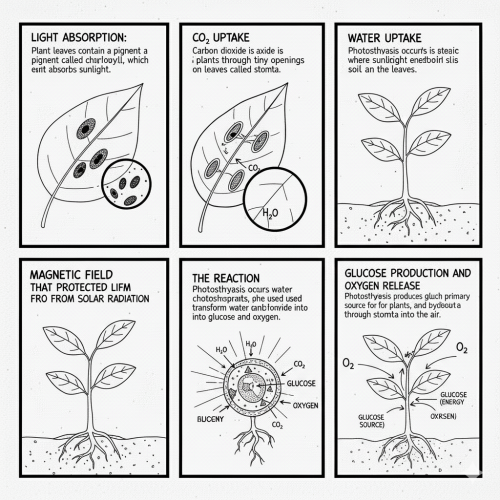
Plants capture energy from the sun, and when animals eat plants, they absorb that energy. Some animals then eat other animals, passing energy along the food chain. But only about 10% of the energy moves from one level to the next — the rest is used by the organism or lost as heat. That’s why ecosystems have many plants, fewer herbivores, and even fewer top predators. A wide base of energy-rich plants is needed to support all the life above them.

A food chain shows how energy flows from one living thing to another — starting with plants and moving up through animals. It’s a step-by-step path of “who eats whom”, and each step in the chain is called a trophic level.
The first tophic level is made up of producers (plants) that make their own food using sunlight (photosynthesis). Next are primary consumers (herbivores that eat plants), followed by secondary consumers (animals that eat herbivores), and then tertiary consumers (top predators that eat other animals).
Each time energy moves up a trophic level, only about 10% of it is passed on — the rest is used by the organism or lost as heat. That’s why food chains usually have lots of plants at the base, fewer herbivores, and even fewer predators at the top.
A food web is a more realistic and complex version of a food chain. Instead of showing just one line of “who eats whom,” a food web maps out all the feeding relationships in an ecosystem — showing how many plants and animals are connected through energy and food.
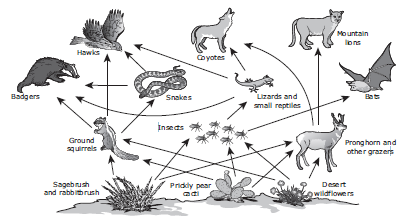
In nature, most animals eat more than one kind of food, and many species share the same food sources. For example, in a chaparral ecosystem, a coyote might eat rabbits, insects, fruit, or even carrion — while those same food sources are eaten by owls, bobcats, or snakes. A food web shows these overlapping paths and helps us see how energy moves in many directions, not just one. It also shows why biodiversity is so important — when one species disappears, it can affect many others that are connected in the web.
A keystone species is a plant, animal, or other organism that has an especially important impact on the structure and health of its ecosystem.
Even if it’s not the most abundant species, the entire ecosystem depends on it. If you remove a keystone species, the system can become unbalanced or even collapse.
Think of it like the keystone in an arch: remove the keystone, and the whole arch falls apart.
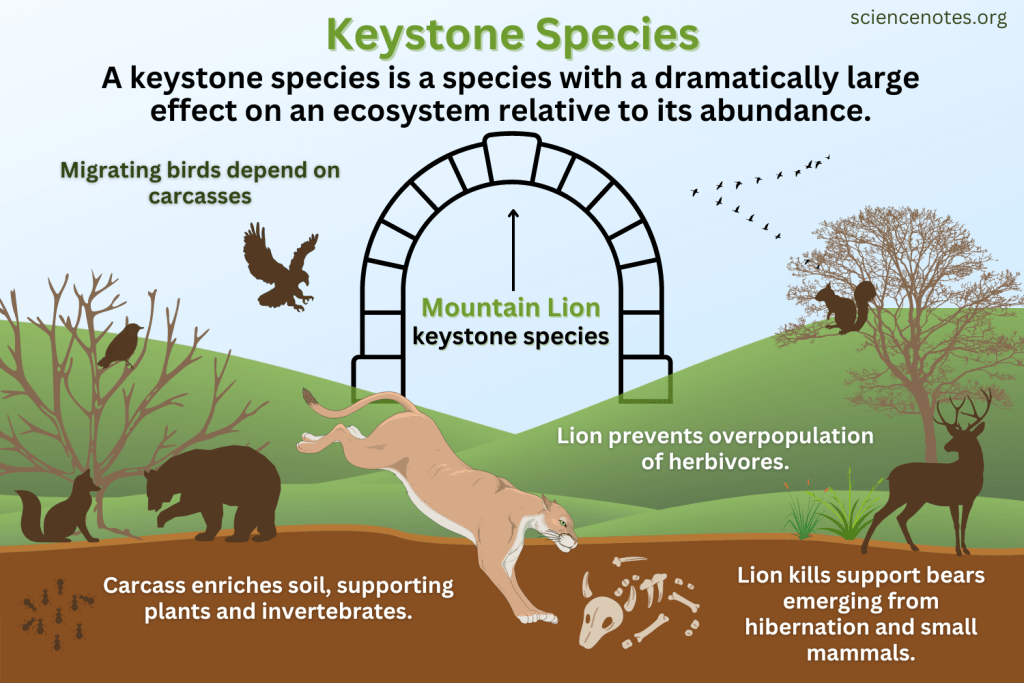
A trophic cascade is a chain reaction that happens when a keystone species— like the removal or return of a top predator — causes effects all the way down through lower trophic levels.
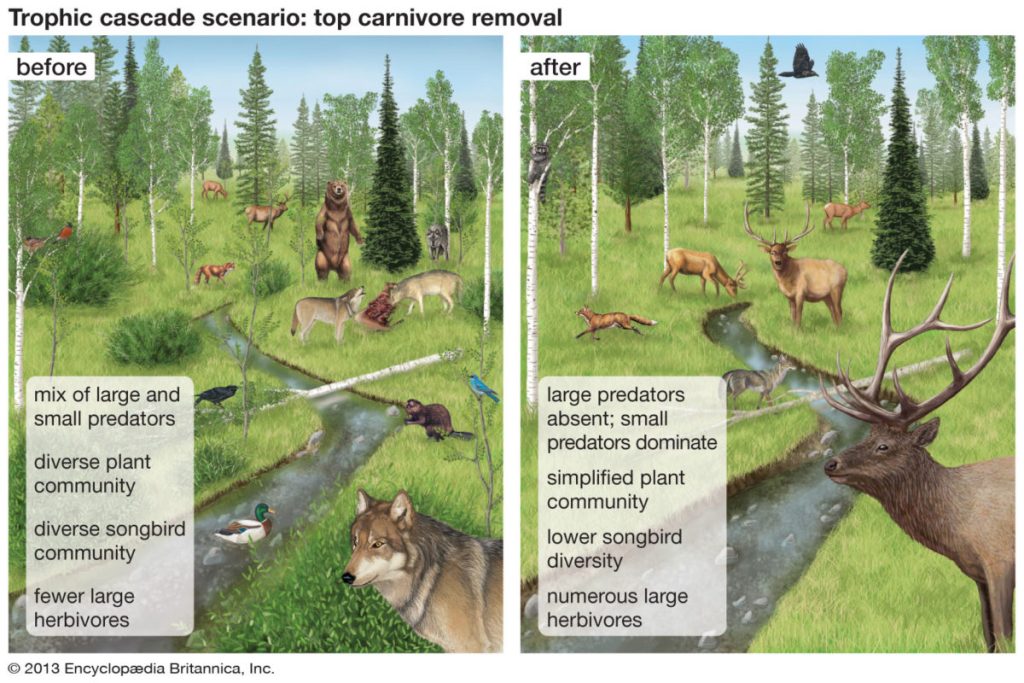
For example, if a mountain lion disappears, deer populations might grow too large, leading to overgrazing of native plants. That plant loss can then affect insects, birds, and even soil health.
Trophic cascades show how every part of the food web is connected — and how one change can ripple through the entire ecosystem.
A kinship cluster is a group of living things that are connected by how they depend on each other to survive. In an ecosystem like the chaparral, these clusters include plants, animals, fungi, and microbes that share food, shelter, or energy in different ways. Together, these clusters create the web of relationships that keeps the whole ecosystem in balance.
Pollination is the process that allows plants to make seeds and reproduce. It happens when pollen from one flower’s male part (the anther) is moved to another flower’s female part (the stigma). Many plants can’t do this on their own—they rely on arthropods like bees, butterflies, and beetles, and on birds like hummingbirds, to carry pollen as they move from flower to flower searching for nectar. These animals act as messengers, helping plants share genetic material and produce fruits and seeds, which keeps the ecosystem healthy and diverse.
Core relationship: Plants ↔ Arthropods ↔ Birds

Once a plant is pollinated, it can produce a seed, which allows it to spread and reproduce, ensuring the next generation of plants. Seed and fruit dispersal is how those seeds travel to new places where they can grow. Many plants rely on birds and mammals to help with this process. Birds eat fruits and later drop the seeds far from the parent plant, often with a bit of fertilizer from their droppings. Mammals like coyotes, squirrels, or deer carry seeds on their fur or bury them in the ground and forget about them. These animals help plants move into new areas, reduce competition, and keep the chaparral full of life and variety.
Core relationship: Plants ↔ Birds ↔ Mammals
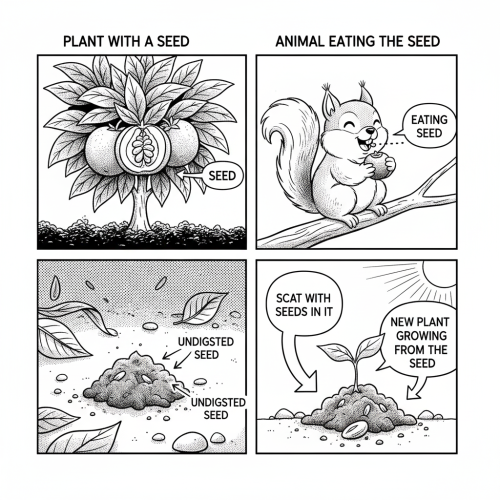
Shelter and habitat engineers are plants and animals that create or shape places where other living things can survive. In the chaparral, plants like shrubs and oaks provide shade, nesting sites, and protection from predators. Mammals such as ground squirrels and gophers dig burrows that become homes for insects, reptiles, and small birds. Arthropods like ants and beetles help build healthy soil by moving and breaking down organic matter. Birds use twigs, leaves, and spider silk to build nests within shrubs and trees. Together, these species form a network of shelter and structure—each helping to create and maintain the habitats that support the entire ecosystem.
Core relationship: Mammals ↔ Arthropods ↔ Birds ↔ Plants
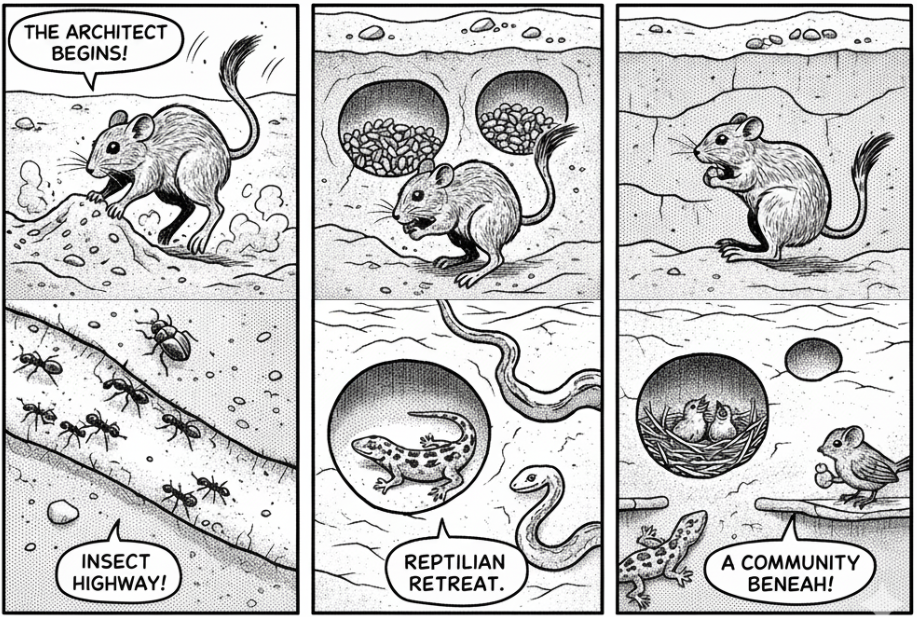
Decomposition and the soil nutrient cycle are the processes that break down dead plants and animals and return their nutrients to the soil, keeping the ecosystem healthy. In the chaparral, fallen leaves and branches are broken apart by arthropods like beetles, ants, and termites, while microbes and fungi continue the work at a microscopic level—breaking organic matter down into nutrients plants can use again. Mammals such as gophers and mice mix and aerate the soil as they dig, helping spread these nutrients. Together, plants, animals, fungi, and microbes keep the soil alive and fertile, creating a continuous cycle of growth, decay, and renewal.
Core Relationships:
Plants → Arthropods→ Fungi & Microbes → Plants → Mammals
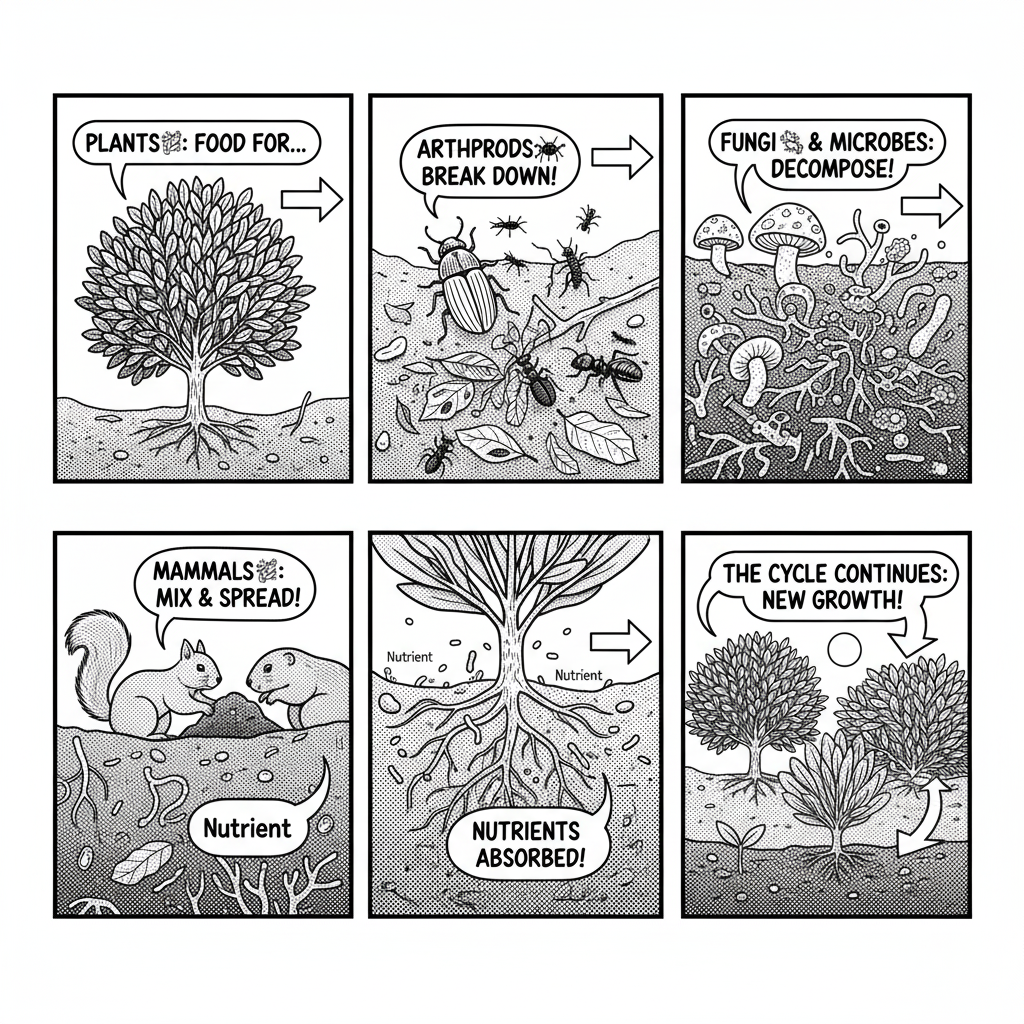
Microorganisms — also called microbes — are tiny living organisms that are too small to see with the naked eye. They exist all around us — in soil, water, air, and even inside other living things.
Though invisible to the naked eye, these tiny organisms shape the world from the ground up. They break down dead plants and animals, recycle nutrients into the soil, and help form the very foundation of every ecosystem. Without them, nutrients would stay locked in dead material, and new life couldn’t grow. In water, microbes help clean pollutants and even produce oxygen — making them essential to both land and aquatic ecosystems.
Microorganisms also play a critical role in supporting plant and animal life. In the soil, some bacteria and fungi form partnerships with plant roots, helping them absorb nutrients and water — especially in dry, nutrient-poor environments like Los Angeles’s chaparral. Others protect plants from disease or help them recover after fire. Even inside our own bodies, microbes aid digestion, support our immune systems, and help us stay healthy. Though we don’t often see them, microorganisms are the silent workers behind nearly every living system — keeping ecosystems balanced, fertile, and full of life.
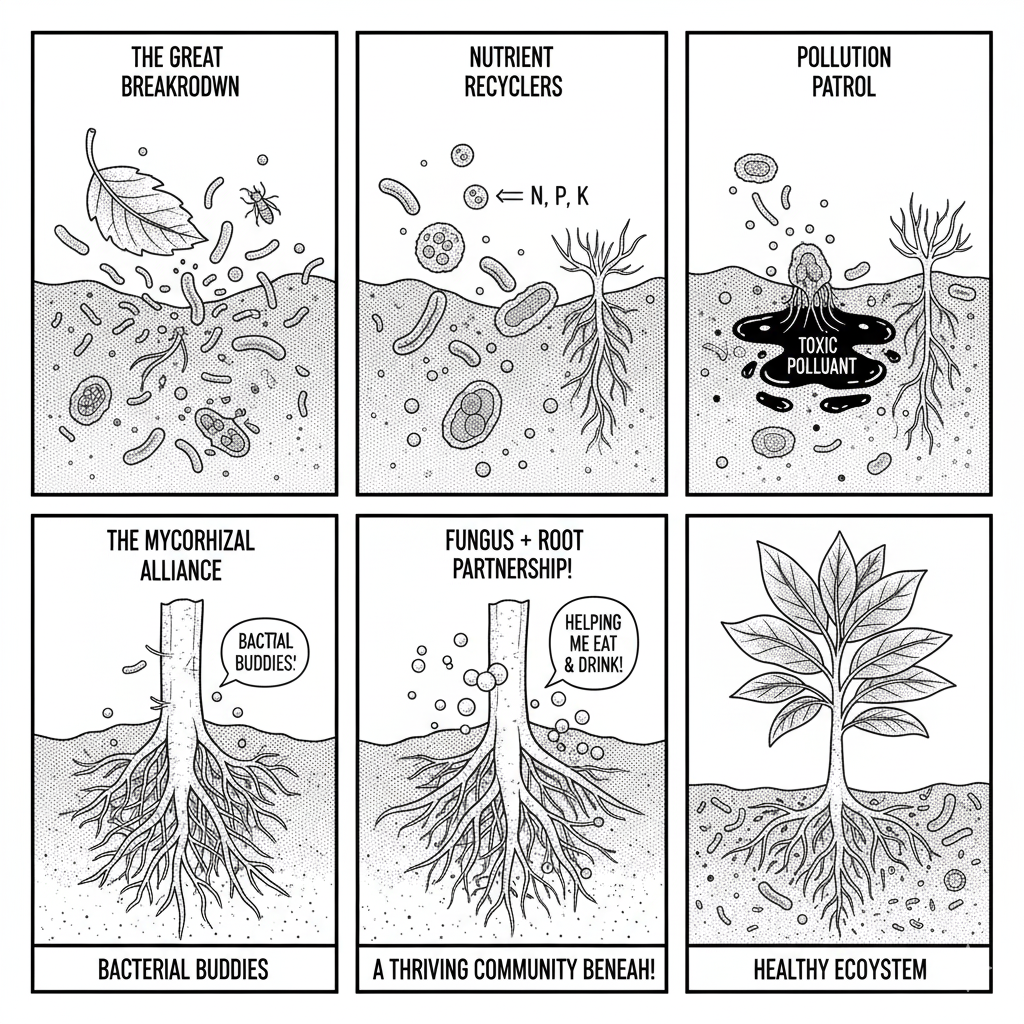
Native plants and animals are species that have evolved in a particular region over thousands — even millions — of years. During that time, they adapted to the local climate, soil, fire cycles, and seasonal rhythms, forming deep relationships with other native species. For example, native plants in Los Angeles like coast live oak or California buckwheat support native insects, birds, and mammals that rely on them for food and shelter. These species have co-evolved to create a balanced, interconnected system where each organism plays a role in keeping the ecosystem healthy and resilient.
Non-native species, on the other hand, are organisms that were introduced from other parts of the world — often by humans, either on purpose or by accident. Because these species did not evolve with the local environment, they may not have natural predators or limits in their new habitat. This can allow them to spread quickly, outcompete native species, and disrupt the ecosystem. When that happens, they’re called invasive. It’s important to note that not all non-native species are invasive, but all invasive species are non-native. A native species, by definition, cannot be invasive in the ecosystem where it evolved — it belongs there. Understanding these differences helps us protect local biodiversity and restore balance to the places we call home.
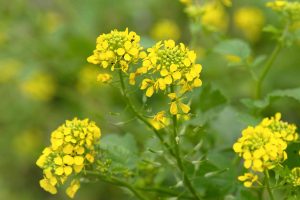
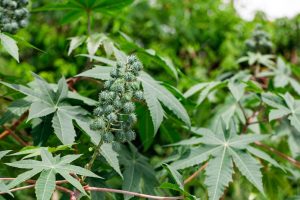
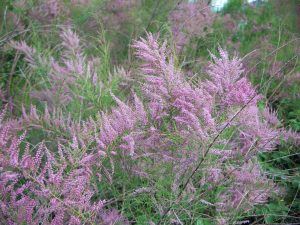
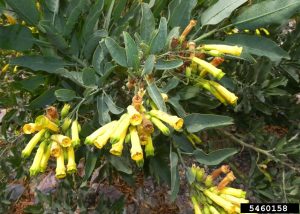
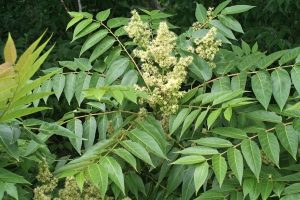



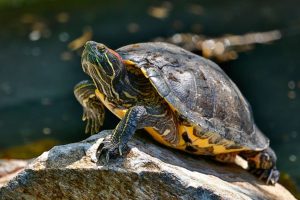

Humans have had a profound and often extractive impact on the natural world. For thousands of years, people have taken what they needed from ecosystems — food, water, wood, minerals — but in modern times, this extraction has become more intensive, widespread, and disconnected from the natural systems that sustain it. We build, consume, and expand without always considering the cost. Natural systems that evolved over millions of years to maintain balance are now burdened by pollution, deforestation, habitat loss, and climate change. The pace of human activity has outstripped nature’s ability to regenerate, pushing many species — and ecosystems — toward collapse.
Urban development has played a particularly powerful role in this unraveling. Many of the world’s cities were established in places that were once among the most biodiverse and ecologically rich — areas with rivers, wetlands, fertile soil, and moderate climates. These landscapes offered everything early civilizations needed to thrive. But as cities grew, they paved over wetlands, rerouted rivers, removed native vegetation, and replaced living ecosystems with concrete, lawns, and infrastructure. In doing so, they eroded the very fabric of the natural world. What remains are fragmented patches of habitat and stressed wildlife populations struggling to survive in altered environments. Understanding this history is essential if we hope to shift from extraction to restoration — and rebuild a future where both people and nature can thrive.
•Distance from the Sun: Earth is in the “Goldilocks zone” — not too hot, not too cold — allowing liquid water to exist, which is essential for life.
•Liquid Water: Water is the universal solvent, needed for chemical reactions in all known forms of life. Earth has vast oceans, rivers, lakes, and even water underground.
•A Protective Atmosphere: Earth’s atmosphere provides oxygen to breathe, carbon dioxide for plants, and shields life from harmful solar radiation and extreme temperatures.
•A Stable Climate and Magnetic Field: Earth’s mild temperatures, regular seasons, and magnetic field protect life and maintain balance. These conditions help keep ecosystems stable over time.
•Photosynthetic Life: Plants and algae use sunlight to create food and release oxygen through photosynthesis. They form the base of nearly every food chain and support the entire web of life.
Yes